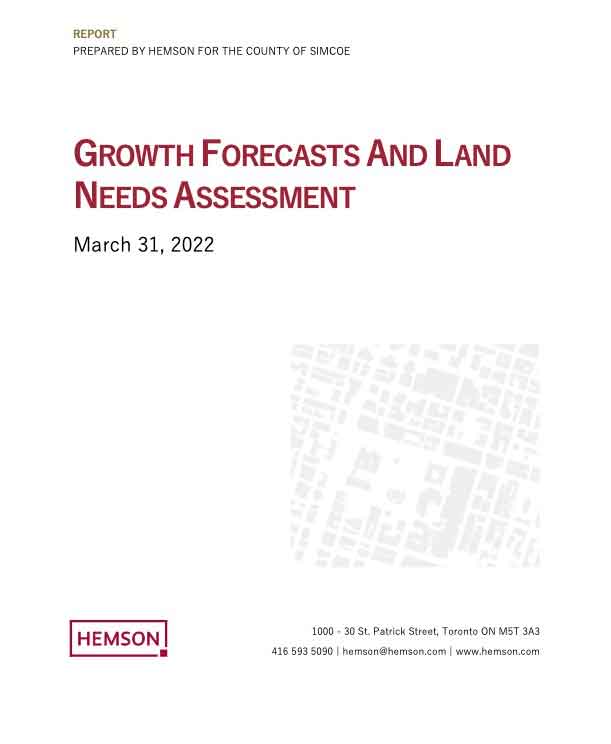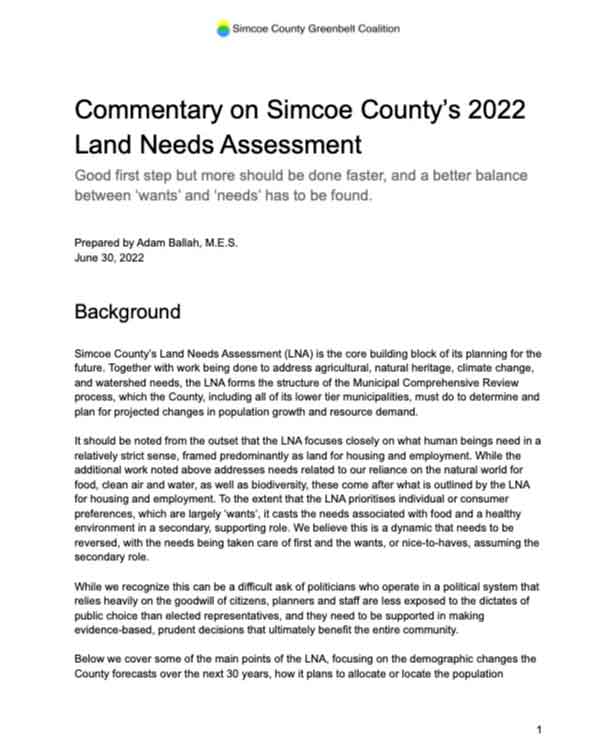Background
Simcoe County’s Land Needs Assessment (LNA) is the core building block of its planning for the future. Together with work being done to address agricultural, natural heritage, climate change, and watershed needs, the LNA forms the structure of the Municipal Comprehensive Review process, which the County, including all of its lower tier municipalities, must do to determine and plan for projected changes in population growth and resource demand.
It should be noted from the outset that the LNA focuses closely on what human beings need in a relatively strict sense, framed predominantly as land for housing and employment. While the additional work noted above addresses needs related to our reliance on the natural world for food, clean air and water, as well as biodiversity, these come after what is outlined by the LNA for housing and employment. To the extent that the LNA prioritises individual or consumer preferences, which are largely ‘wants’, it casts the needs associated with food and a healthy environment in a secondary, supporting role. We believe this is a dynamic that needs to be reversed, with the needs being taken care of first and the wants, or nice-to-haves, assuming the secondary role.
While we recognize this can be a difficult ask of politicians who operate in a political system that relies heavily on the goodwill of citizens, planners and staff are less exposed to the dictates of public choice than elected representatives, and they need to be supported in making evidence-based, prudent decisions that ultimately benefit the entire community.
Below we cover some of the main points of the LNA, focusing on the demographic changes the County forecasts over the next 30 years, how it plans to allocate or locate the population increase and changes this forecast projects, as well as the employment needs associated with that.
There are six main components that we address, covering the population forecast and demographic shift through 2051, the degree and type of housing needed to meet these changes, where that housing should be located, the availability of land in those areas to accommodate it, associated employment needs, and, putting all of this together, whether there’s a need for additional land.
For each area we outline what the LNA calls for, give comments and analysis from our perspective, and then provide a recommendation.
Population Forecast and Demographic Shift
Outline
Simcoe County is expected to plan for an increase in population over the next 30 years, from the current 360,670 to 555,000 in 2051.
The average annual growth rate associated with this is 1.4%, which is less than what is experienced in the previous 30 year time-frame, of 1.9%. That growth rate peaks at 2.8% in 2021, tapering over consistently as we get closer to 2051, which has an expected growth rate of 1.2%.
Most of this increase in population is expected to result from in-migration from the GTA.
A recent change to the Growth Plan established the population target of 555,000 noted above as a minimum. The County states that these forecasts are reasonable, implying that it is unlikely that it is unlikely a higher figure will be planned for.
Comments
There is a big asterix that needs to be appended to any planning for housing needs, which we will get into in further detail below, but for now it is important to recognize that dramatic shifts in demand can be difficult to foresee. A prime example of this just occurred when, due in part to COVID-19, many living in urban centers took advantage of an increase in remote work arrangements and sought the perceived safety of more rural communities.
Furthermore, impacts from climate change, some, though not all, of which are highly unpredictable, paired with the persistence of remote work arrangements, the appeal of living in areas less exposed to high temperatures (heat island effect in urban areas) as well as options for enhanced food resilience, with gardens and local food options, may contribute to greater pressure on rural policy areas than anticipated.
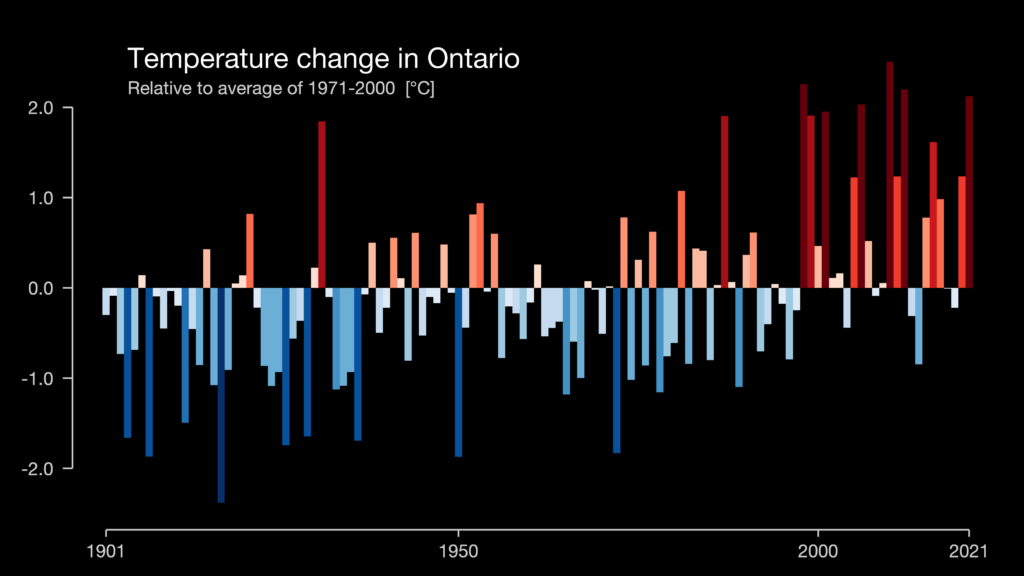
“Warming Stripes” showing temperatures change in Ontario since 1901. These can be customized and downloaded here.
Credit: Ed Hawkins, University of Reading
This climate-induced dynamic could exacerbate the factors that cause it creating a positive feedback loop, with increased reliance on cars due to rural living, more spread out and costly infrastructure demands (paired with less urban intensification and infrastructure efficiencies), greater stress on natural resources, and less social cohesion.
Recommendations
Municipalities can reduce their exposure to potential future out-migration by enhancing the livability of their built environment, prioritising areas in which they have an advantage, such as access to amenities and employment, as well as a vibrant social and cultural life.
Livability of the urban areas can be addressed by prioritising the urban tree canopy and green spaces, which will help with cooling, reducing the urban heat island effect that is likely to become problematic with climate change, focusing on access to amenities such as grocery stores, schools, cafes, parks, and all the other things that make living in urban areas great. A key component of this access is easy and affordable transit options so that residents can get to work, or travel elsewhere, without having to own a vehicle, creating a cost-advantage to urban over rural life.
This cost advantage that urban areas offer over rural living is greatly under-realized in many of our communities. The phasing approach as outlined by staff in the Draft Growth Management Amendment (DGMA), as well as direction to Innisfil and BWG that they focus on building complete communities in the areas surrounding the proposed Go stations, is a good start towards ensuring that built-up areas are more fully realized before new development expands the urban envelope.
Many of the advantages of the urban built form, as indicated above, have to do with proximity. If a resident is able to easily access amenities they can choose to not own a personal vehicle. Car ownership is an estimated average cost of more than $10,000 per year per vehicle for Canadians.1The Canadian Press. “Cutting the costs of vehicle ownership by buying and driving less.” CBC, 31 August 2017, https://www.cbc.ca/news/business/car-ownership-costs-1.4269992. Accessed 25 June 2022.
For a typical family that owns two vehicles this equates to more than $20,000 each and every year that is freed up. This money represents what is, by and large, an outflow of capital from the community, going to fossil fuel companies, banks, and car companies. By giving this money back to residents much of it can be recaptured by the local economy, going, instead, to restaurants, property upgrades, charitable causes, business start-ups, to name a few possibilities.
Some of this freed money will, of course, be spent on transit fares, but public transit is far more efficient to operate than personal vehicles infrastructure, especially when negative externalities, like health impacts due to air pollution, which in Canada alone costs an estimated $120 billion per year2Environment and Climate Change Canada. “Health impacts from air pollution.” Canada.ca, Government of Canada, 20 May 2022, https://www.canada.ca/en/environment-climate-change/campaigns/canadian-environment-week/clean-air- day/health-impacts-air-pollution.html. Accessed 25 June 2022., are accounted for. Additionally, in relation to the efficiency of public transit, economies of scale can be achieved with greater density in urban areas, helping to reduce the amount per unit of infrastructure for municipalities and enabling expenditures elsewhere, such as on the public amenities such as parks, libraries and community centers, and tree canopy noted above.
Housing Needs Forecast
Outline
There are two subcomponents of this section, the Historical and Forecast Housing Growth, which looks at the aggregate trend, and the Market Based Housing Forecast, which tries to determine the future mix of housing types of Forecast Housing Growth based on historical trends.
Historical and Forecast Housing Growth
The County expects the number of households to increase from 132,480 in 2021 to 231,560 in 2051. In absolute terms, however, the rate of household growth between 1991 – 2021 was 70,650, while between 2021 – 2051 it is projected to be 99,080.
This rate of household growth, paired with population growth, equals a household density, according to the LNA (dividing the population by the number of households) for 2051 of 2.39, which is a reduction in the current density of 2.72 in 2021. (For context, the average household size in Canada in the 2016 census (2021 census data is not publicly available yet) was 2.47, and the average Ontario household size was 2.58.3Statistics Canada. “Appendix G – Estimated number of households and average household size by domain, Canada.” Appendix G Estimated number of households and average household size by domain, Canada, Government of Canada, 13 December 2017, https://www150.statcan.gc.ca/n1/pub/62f0026m/2017002/app-ann-g-eng.htm. Accessed 25 June 2022.)
One of the key demographic shifts Ontario needs to prepare for in the coming years is the ageing of the Baby Boomers. As we can see in the charts below, the County forecasts an increase in seniors, with the 30 year time period matching a shift from the 50-55 year category to the 80-85 year category.
This shift to an older population is not unique to the County, and reflects what the province as a whole will be experiencing. In line with this the Ministry of Finance notes that “the number of seniors aged 65 and over is projected to almost double from 2.6 million, or 17.6% of population, in 2020 to 4.5 million, or 22.2%, by 2046.4Ministry of Finance. “Ontario population projections | ontario.ca.” Ontario Population Projections, Government of Ontario, 23 June 2021, https://www.ontario.ca/page/ontario-population-projections. Accessed 22 June 2022.
The corollary to the above shift is the decline of the 15-64 age group as a share of total population, from 66.9% in 2020 to 62.9% in 2046.5Ibid.
Market Based Housing Forecast
The LNA relies heavily on consumer preferences from the past 20 years to forecast future preferences.
As indicated on the chart below, the County anticipates that the housing mix will shift slightly away from single-detached and semis, towards more row and apartment units, and slightly more accessory units.
The negative 7% shift away from singles and semis is made up by a shift towards rows, apartments, and accessory units.
This shift is a step in the right direction, but, as the trendline in the chart below indicates, it’s a slow, almost hesitant, step in the right direction, with a slight decline in singles and semis and a slow uptick over time in the more compact (and generally more affordable) rows, apartments, and accessory units.
In effect what we see over the next 30 years is a relatively static housing mix at a time when we really need to be reducing singles and semis and increasing apartments and more compact built forms of housing.
Comments
As touched on above in relation to population forecast, this change in demographic, from a middle-aged demographic to a 65+ demographic, contrasts with the recent changes to the housing market that occurred with COVID 19. Many younger families moved out of urban centers in search of both less crowded areas, with the corollary increase in remote work that many expect to remain to some degree into the future, and cheaper housing, with the ‘drive until you qualify’ dynamic seen as house prices skyrocketed.
The contrast between the population projection, along with the demographic shift, noted above, and the recent reality of the market as seen during COVID 19, raises questions about the reliability of the LNA as it currently stands. This is exacerbated with the heavy reliance on “Market Based Housing Forecasting” to determine need, since the market, as we’ve seen, can change swiftly and dramatically based on unforeseen events, such as a global pandemic.
The MBHF appears to use a number of assumptions, with a primary one being based on the age of the “primary household maintainer” and using that to determine the type of household required, such as “single person, single-parent, couple households with or without children at home, and non-family households.” This excludes types such as multi-generational households, as well as live-in care-giver households and others. Some of the household types excluded may offer solutions to affordability concerns.
The MBHF assumes a static cultural dynamic, or that past patterns and preferences will continue mostly unchanged into the future. Given the problems in the housing market today and the dramatic shifts we’ve seen over the past few years, believing that the past is predicative of the future to any considerable degree seems to be an irresponsible approach.
Rather than relying on the MBHF to project future demand based on past trends a focus should be on creating a built form that can be relatively easily repurposed, adapted, and extended for changing needs. Providing the opportunity for seniors to age-in-place by allowing secondary suites can help address affordability concerns, allowing the home-owner a revenue stream while simultaneously increasing housing stock as well as density.
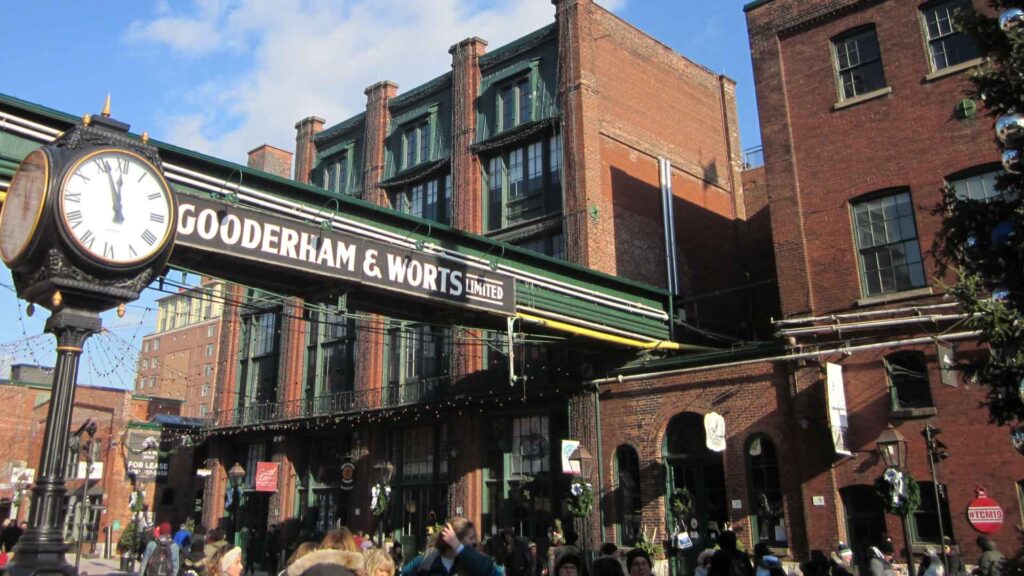
The Distillery District in Toronto has become a destination for events and celebrations, as well as providing office and living space within a fairly small footprint.
The buildings were repurposed from old industrial uses.
Recommendations
In light of this, and the inherent uncertainty in planning for a long-term horizon, which is greatly increased due to climate change, we suggest that the most prudent approach is to plan in a way that prepares for uncertainty. Increasing the number of real-time options that residents can utilise in their day to day life gives the flexibility to change and adapt according to the needs of a given situation.6Real-time” options are distinct from market options, in that they present an array of choices that can be made at any given time, as opposed to a market option, which, once chosen (or bought) is locked in for a longer period of time. An example of the former is access to amenity accessibility options that include walking, cycling, public transit, as well, possibly, as car share and/or car ownership. An example of the former would be simply car ownership without the option of walking, cycling, or taking public transit.
Ensuring that development is done in a way that can be modified at a later date, such that creative solutions can be found to changing circumstances, both hedges against the possibility of being stuck with a ‘white elephant’, or a built form that isn’t suitable to a changed environment, as well as offers the possibility for a multiplicity of uses, which can benefit entrepreneurs and others who positively challenge the status quo. A simple example of such a built form is the transformation that derelict urban industrial areas have seen over the past few decades, with old warehouses becoming housing, lofts, studios, cafes, and work spaces. The larger space of these buildings can be subdivided or expanded, depending on need, allowing for multifaceted uses.
To the extent that Market Based Housing Forecasting prioritises single detached homes it is the antithesis of the above approach. These buildings, while accessory units and secondary suites can be added, are nevertheless far more expensive and difficult to convert into the types of spaces that foster the flexible dynamism noted above. The infrastructure surrounding them, by and large, remains problematic with a high reliance on cars, which many who spearhead startups cannot afford, with the bulk of their income being devoted to their enterprise. (Reducing reliance on cars and the costs associated with them is another way of supporting economic dynamism because it helps entrepreneurs put a greater portion of their money into their venture.)
Furthermore, MBHF has a poor predictive track record. On the face of it this is a relatively simple conclusion given how poorly the market has performed in the past few years, but numbers back it up. Data out of Waterloo gathered by former Director of Community Planning, Kevin Eby, shows that past predictions of housing mix sorely missed the mark when compared to actual builds. Accordingly, we believe MBHF should only be used with caution to determine future housing in a very general sense.
Finally, doing away with exclusionary zoning is an important step in encouraging a more diverse, flexible housing mix. This is a move that is increasingly supported by planners and community leaders both within Ontario and beyond as one of the best ways to address problems in housing and community affordability. This is a crucial proposal and we cannot express our support for it strongly enough.
Housing Needs Allocation
Outline
Housing needs are allocated to certain areas in the County based on historic growth trends, requirements of the Growth Plan that direct growth towards primary settlement areas, as well as distribution of future supply by policy area (Delineated Built-Up Area / Designated Greenfield Area (DGA) / Rural).
Growth allocated to lower tiers relative to the 2021 population is shown in the chart below. Much of the growth is in BWG, Innisfil, and New Tec, all of which are in the Southern Regional Market Area (SRMA) and all of which are expected to nearly double in size.
The LNA states that about 64% of all population growth is expected to occur in the Southern RMA (55), with 20%, 18%, and 20% growth for Innisfil, New Tec, and BWG respectively. (Percentages shown in the chart above are per municipality rather than of the total.)
The flip in housing allocation from more in the Northern RMA to more in the Southern RMA is highlighted in the chart below.
Comments
The overall shift of population from the NRMA to the SRMA, with the increase in availability of services and proximity of employment, is good. It raises concerns, however, with respect to increased localised resource demand, specifically with respect to ecosystem services. The fact is that an increase in population tends to increase demand for natural resources. The high quality of life that we all want for our region going forward will depend either on our ability to maximise the efficiency of these resources, or on increasingly expensive fixes to ecosystem failures.
Water and wastewater are obvious examples, with pressure on the capacity of local water bodies, in particular Lake Simcoe, already severe. Food, as we’ve recently experienced, can be another vulnerability, with prices increasing dramatically and long supply chains causing some items to disappear from shelves for periods of time.
Many of these issues are more easily addressed with increased density. As noted above, greater efficiencies can be found with infrastructure for more compact communities, helping to drive down costs and isolate pollution sources for treatment. Increasing density, however, comes with its own set of problems, many of which are sociological in nature. NIMBYism and a preference for single-detached housing, along with car culture, and other consumer oriented behaviour, driven to a large extent by marketing campaigns, makes it difficult for elected leaders and the staff who support them to implement these needed changes.
Recommendations
While planning tends to be viewed as a highly technical exercise, it is increasingly clear that there is a disconnect between what needs to be done and what some members of the public, often a vocal minority, are willing to accept. To increase the ability of local governments to proceed with projects that may spark NIMBY backlash, more effective dialogue is required at the community level.
The case needs to be made that infill and intensification are more cost effective solutions, enabling higher quality, more affordable communities. This, in turn, can reduce the burden on the taxpayer and provide greater flexibility for governments with spending priorities.
Community organisations, as well as local business associations, can be important partners in amplifying change at the grassroots, local, community level, and should be engaged in learning and promoting the benefits of a more compact built form and creating the policial space required so that elected officials can implement these changes with greater confidence of public support.
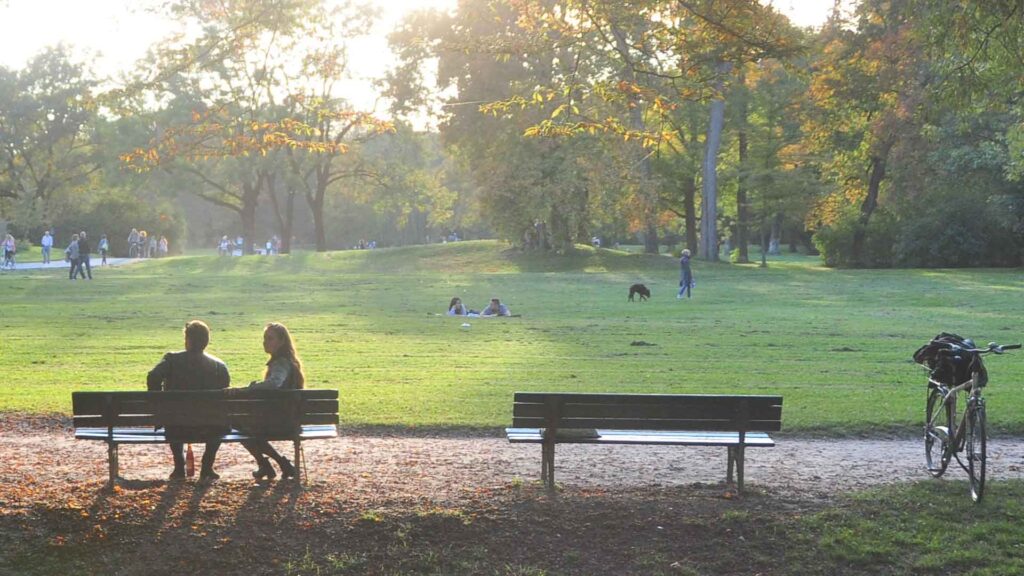
Many of the attributes that we most value in urban settings, such as public parks in which people can meet and spend time, are made more possible by greater density in surrounding areas.
NIMBYism is, in a sense, a lack of faith in the ability of government to provide these spaces that enable a high standard of public life.
Housing Supply Potential
Outline
Housing Supply Potential (HSP) outlines where and to what extent the policy areas that can accomodate housing currently exist in lower tier municipalities. The policy areas are, Rural Area (RA), Delineated Built-Up Area (DBUA), and Existing Greenfield Area (EGA). Due to past allocation there is a large amount of potential identified in the NRMA, though this should not be seen as indicative of where future allocation will occur.
The intensification target established by the Growth Plan for Simcoe County is 32% within the DBUA. The LNA estimates that Simcoe County’s BUAs, based on size, location, and capacity, can accommodate an intensification of 36%.
Intensification in the NRMA is inline with current rates, while that proposed for the SRMA is characterised as “more transformational change.”
To achieve the intensification targets in the BUAs redevelopment of current lots and apartments will be required.
Comments
Rural Areas
Existing supply is not expected to grow, except in municipalities without urban settlement areas. Demand is calculated based on the level of construction in recent years. It should be noted that while the LNA states the County is not expected to proactively support an increase in construction in this policy area, this is not the same as stating that construction would be discouraged and directed toward DBUAs or EGAs.
Delineated Built-Up Area
The LNA states that, “only development occurring within the [D]BUA is used to meet the minimum intensification target.” Given that growth targets are now set as minimums, this acknowledgement that growth within the DBUA is likely to be prioritized, to the extent that the municipality is working towards meeting its growth targets, is welcome.
Existing Designated Greenfield Area
DGA density targets are higher than what’s in the OP, both due to provincial and local policy direction to promote more compact built forms, and to the fact that when the OP was adopted in 2016 Employment Areas were included in the DGA density calculations, and, reflecting more recent changes in the Growth Plan, they no longer are.
The 2016 OP density targets averaged out to 39 residents and jobs per hectare, while the 2051 LNA target averages 51 residents and jobs per hectare.
Minister’s Zoning Orders (MZOs) are treated as DGA supply in the LNA, so developments like The Orbit and Tollendale Village are included in the density targets. While we are not necessarily opposed to MZOs being included in density targets, we do have concerns.
A development, even if it’s a more compact built form, if it’s separated from services and amenities, such as transit, grocery stores, or medical offices, is not in keeping with what we believe the County needs in terms of its built form over the coming decades, which seems to be more or less reflected in the LNA document. MZOs often tend to be located away from DBUAs and, as such, too easily lead to fragmented regional planning.
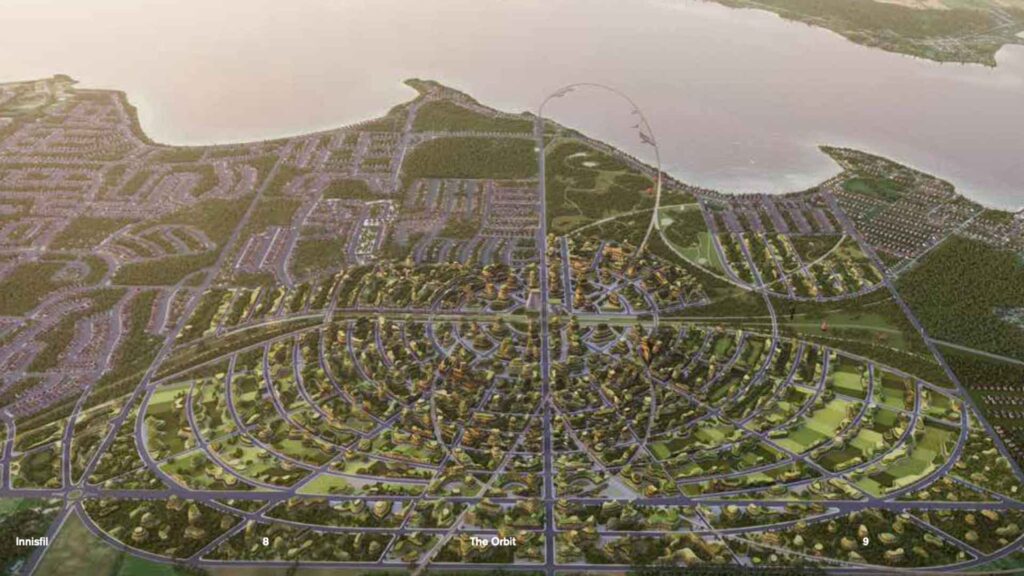
The Orbit, a mega-development that has been granted a MZO, is situated on farmland outside of Innisfil’s DBUA and Primary Settlement Area of Alcona.
Recommendations
Given that the shift in supply potential from the NRMA to the SRMA is significant, questions need to be asked of why this occurred. What factors led to such a large amount of land being zoned in an area that now seems unlikely to meet that need? This may indicate the need for greater insulation of the planning process from political direction, whether that comes from elected officials, business interests, or community organizations and individuals (including the NIMBY dynamic).
Planning should proceed to as great an extent as possible based on objective needs first, and then political wants second. It is too important to the good function of our communities to allow this to hinge on political winds of the day, particularly since the costs of changing projects often increase exponentially.
With respect to the inclusion of MZOs as DGA supply, we encourage the County and municipalities to only seek MZOs for a very limited scope of projects and as a last resort. This is a tool that was not intended for use in jurisdictions with planning departments, and it’s important, as we’ve emphasised above, that public engagement in the planning process be encouraged and due process be followed. If due process is a problem make the case that changes are needed. Don’t do an end run around it.
If an MZO is sought we strongly recommend that conditions are present that enable the co-benefits of the DBUA, including access to services and amenities noted above.
Community Area Employment
Outline
Community Area Employment (CAE) seems to be distinct from a more general sense of employment, in that it addresses jobs that occur within a community “mainly to provide services to a resident population.” Employment, such as provided by the Honda plant in Alliston, presumably, would not fall under this category since it provides jobs to individuals beyond simply what is found in the resident population. This category, in other words, addresses what is important to the functioning of a given community.
There are two scales identified: neighbourhood, which are local retail and services, schools and other institutions, and work at home employment. Beyond this, but still within the Community Area, are jobs related to larger institutions that serve a larger segment of the population (such as high schools and post-secondary institutions).
Land needs assessed for CAE include what is needed to support infrastructure for these activities, such as stormwater management facilities, child care centres and local schools, roads, etc.
DGA density targets include CAE considerations. This means that when land needs are calculated for something like a subdivision the amount of land required to service it is included as well. The “net to gross” ratio used, the LNA notes, based on existing plans for subdivision, is between 50% to 65%. In other words, more than half of the land that we develop under current patterns is devoted to uses that support, or are secondary, to the primary land use.
Comments
It’s worth noting that CAE presents a certain picture of what an appropriate amount of services necessary to support a community is. The 50 – 65% net to gross community area devoted to supporting primary uses, for example, is a shockingly high amount, with much of that proportion being devoted to roads and other impervious surfaces. Factor in that lawns are not included in this community area infrastructure and the amount of land that we actually use for production, rather than in support of that production, begins to look extremely wasteful.
(What other areas of life would a 50 – 65% loss rate in productivity be acceptable? Cars utilising internal combustion engines, with an average efficiency of only 25% energy to movement transfer, are a glaring example, but they prove the point of just how inefficient our current land-use patterns are.)
These inefficiencies aren’t simply lost inputs or externalities to production, rather they have costs of their own. Roads are expensive to maintain, and give opportunity to healthcare costs resulting from accidents, not to mention pollution, whether from engine emissions, brake dust, or externalities that are further removed like costs associated with end of life of electric car components such as batteries.
The fact that lawns, as well as impervious yards and driveways, are not captured by the community area needs metric represents a cost with respect to the passive acceptance of them as characteristic of our communities.7Impervious surfaces are starting to be recognized as problematic, with the City of Barrie charging property owners a fee for impervious surfaces starting in 2023. Revenue collected will go towards its Stormwater Climate Action Fund. City of Barrie. “Stormwater Climate Action Fund.” City of Barrie, https://www.barrie.ca/Living/Environment/Wastewater-And-Sewers/Pages/Stormwater-Climate-Action-Fun d.aspx. Accessed 29 June 2022. Lawns are expensive due to water requirements, fertiliser runoff, as well as threats to pollinators and biodiversity more generally.
The type of area devoted to other community employment, specifically with regard to retail services, is important to consider as well. Is this enabling big box stores located on the outskirts of a built up area, which employees need to use (and pay for) a car to get to, or is effort being put towards ensuring that this employment is located in more central locations that foster walkable communities, as well as enable more affordable transportation options for employees through access to public transportation?
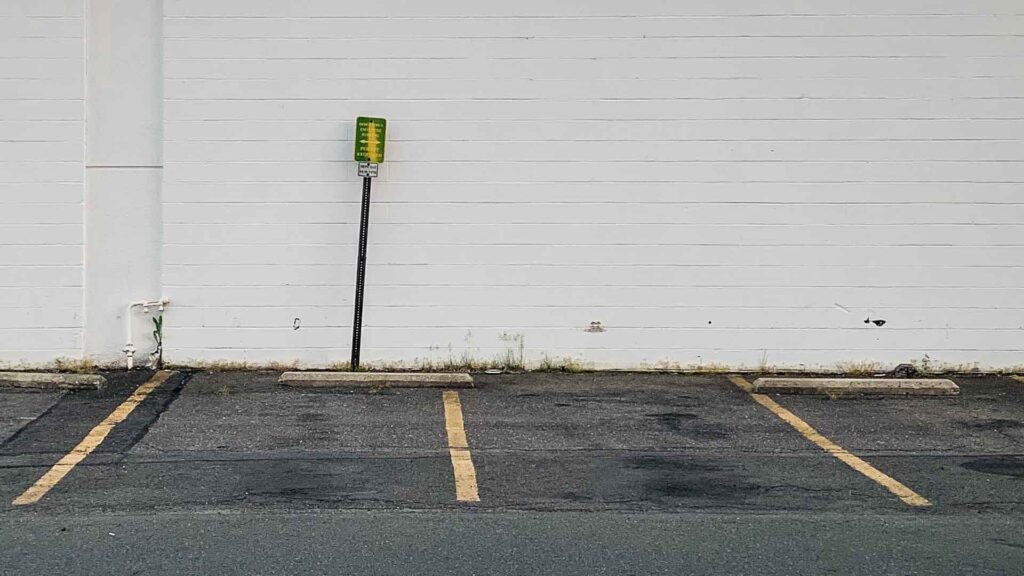
Impervious surfaces, such as paved parking lots, driveways, and streets, as well as roofs, prevent rain water from absorbing into the ground. More water directed into the stormwater system means higher costs for taxpayers.
Barrie is taking steps to address this with its Stormwater Climate Action Fund.
Recommendations
Maximise the efficiency of infrastructure devoted to supporting primary uses. This reduces the burden on municipal budgets and supports a transition toward more compact, complete communities.
Building off of the point above, ensure that CAE is well integrated within the fabric of the community, such that employees and patrons are easily able to access it.
Need for Additional Land
Outline
The final step in the LNA uses the above information to calculate whether there’s a need for additional land and, if so, provides an approximation of that.
According to the calculations in the LNA, assuming all data is accepted as is, the County does not have enough supply to meet projected demand in the SRMA, with a housing shortfall in DGAs of 17,100, resulting in the need for additional land calculated at 1,156 hectares. (For context, the City of Orillia is 2,270 hectares with 14,275 private dwellings, according to the 2016 census.)
The LNA assumes that, “almost all units in the Rural Area in the Northern RMA (96%) are single detached whereas the unit mix in the Rural Area in the Southern RMA is broader—77% singles/semis; 16% rows; and 7% apartments.”
SRMA DBUAs have a unit mix that is heavily weighted toward apartments, with 70%, however, as the chart below shows, the mix in the DGA is heavily weighted towards single/semi units. The negative axis indicates a shortage of land available for projected demand, while the positive indicates a surplus.
The projected unit mix for the NRMA is shown below, with a greater emphasis on single/semi and row units than apartments, contrary to what is outlined for the SRMA, above.
Comments
Reliance on the MBHF creates a situation where the additional land needed in either RMA is more than what it would be if a greater emphasis were placed on apartments and more compact built forms.
In effect, the MBHF preferences consumer choice over the needs of the community and the needs of the environment, including the ecosystem services that we all rely on.
For example, the additional lands needed for the SRMA, to the extent they are caused by the inclusion of single/detached homes, would be reduced by half if converted to two story apartment complexes, by two thirds if converted to three story complexes, and so on.
While recognizing there is a real shift towards a built form that is more compact that what has been planned for in the past, the continued heavy weighting towards single detached units in both RMAs remains problematic. Building a majority of units in the single detached form is likely to create problems when future conversion to more compact built forms is desired, particularly with respect to potential NIMBYism, as discussed in previous sections, as well as due to the fact that it is a difficult built form to repurpose. We strongly believe that we should be building for the future we want, and as such anticipating needs associated with less resource intensive, more sustainable communities. Single detached homes are the least efficient type of built form, and, along with associated infrastructure, act to lock in wasteful, carbon intensive lifestyles for decades to come.
Recommendations
MBHF has proven inaccurate and unreliable in other jurisdictions (see discussion in previous sections) and should not be relied on to any great extent.
Planning should be, and we believe generally tries to be, focused on the overall wellbeing of the community, integrating and addressing a wide range of concerns. MBHF rests upon the use of ‘public choice’ as a proxy for governance.
In recent years public choice, as a stand-in for governance, has received heavy criticism. In the context of housing preference, not to mention vehicle preference or just about any other preference associated with a market good, this criticism is well justified.
Marketing is a nearly $500 billion USD industry, the specific aim of which is to convince us of what we want. For most producers, including home developers, this is money well spent. Consumers in the marketplace make choices according to the information they have, and for the most part this information is highly skewed towards what marketers want them to believe.
While the marketplace could function in a way that more clearly signifies the best interests of the public, far more information would be needed by consumers than what is currently available. The market as it currently stands operates largely by externalising costs, such as loss of ecosystem services, health impacts due to over reliance on cars, or increased food insecurity, onto the public. If these costs were fully accounted for the MBHF might be considered an accurate indicator, though the reliance on past performance would remain a weakness – revealed preference , or the notion that choice is a good indicator of preference, simplifies complex circumstances far too much. (Choice is limited by a wide range of factors, including availability, budget constraints, proximity to employment or family, etc.)
In light of this, and to reinforce previous recommendations, it is important that planners, working with community organisations and local business associations, help residents understand the costs associated with single detached homes and, even more importantly, the advantages, including positive economic and health outcomes, that can be gained from living in complete communities. This much needed shift in understanding will continue to be a challenge so long as single detached homes remain the primary unit type.

This screenshot from Ford’s Canadian F-150 site illustrates how the truck is marketed to the public.
The F-150 is the best selling vehicle in Canada, by far, and trucks occupy several of the top positions, yet for the most part the beds, which make up roughly a third to half the vehicle, remain empty the vast majority of the time. This highlights just how powerful marketing is in influencing people’s decisions.
Conclusion
Overall the County seems to be moving in the right direction, placing more emphasis on compact built form and directing more growth to areas closer to the GTA where better public transportation services are more likely to be available, both now and, hopefully, increasingly in the future. (The increase in population and compact communities makes a stronger case for better public transportation.)
That said, given the multiple pressures of climate change, affordable housing, and sticker shock for food and energy, doing everything we can to establish communities that are more resilient, that limit the impact on the natural environment and preserve crucial ecosystem services, and that enable more affordable living (allowing for transportation options other than car ownership, for example, or better access to healthy, local food, or more local business ownership as opposed to chain box stores) is important. Accordingly, while the County is moving in the right direction, we believe that more needs to be done at a faster pace.
To illuminate this point, consider what the Land Needs Assessment takes into account. Relying heavily on Market Based Housing Forecasting (MBHF), which attempts to meet what the consumer wants based on past trends, the Land Needs Assessment (LNA) walks a fine line between implementing a pragmatic solution, balancing competing demands on finite resources, such as land for housing or land for natural habitat or land for agriculture, with simply bowing to the dictates of the market. This later dynamic, the dictates of the market, is exposed to a number of factors that are largely beyond the control of the County, or the provincial or federal government for that matter, such that home prices can rise seemingly without limit, as we’ve seen of late.
The LNA, to the extent that it relies on MBHF, assumes the role of the market as the ultimate arbiter of what is good, positioning a theory of public choice as expressed via purchasing power as a process and part of good governance. We outline some of the problems with this approach, including the role that marketing plays in shaping consumer preferences and the reliance that the market has on externalising costs onto the public.
Furthermore, MBHF provides reactive rather than proactive planning that tends to follow the dictates of the market rather than contribute to it, or, to use the well-worn idiom, puts the cart before the horse.
We believe that if we did urban areas better, including increasing the participation by residents in budgetary decisions so that they realise associated costs, many residents would gladly move away from their preference for single detached homes.
Montreal does urban parks REALLY well, & people clearly LOVE the new Place Fleurs-de-Macadam right on pedestrianized Avenue Mont-Royal. A packed “water square” with interactive water & on-site rain management, “cloudy” art feature & great seating all on a former gas station site. pic.twitter.com/CqyDpMcvj7
— Brent Toderian (@BrentToderian) July 10, 2022
Brent Toderian, one of our favourite planners and urbanists, highlights successful public spaces in these tweets. Note the furniture and abundant space for people to move naturally, accommodating a whole spectrum of activity and rest.
Good public spaces don’t make demands of people, rather they allow and enable people to utilize them as they want and need, making it their own, so to speak.
These are spaces that enhance our sense of contentedness and community, building social cohesion, shared understandings, and civic pride. Ultimately, these are spaces that strengthen democracy.
Ultimately, the way that we build our communities needs to change. This is recognized by the LNA document. Enhancing the built environment in those areas that support the changes we want to see, such that they are able to induce preference change towards them, is crucial. This more proactive approach also underlines the fact that MBHF is malleable rather than predictive.
A key example of where the LNA seems to fail in this regard is the mismatch between the housing allotment and the employment allotment. To enhance the livability of a community measures that reduce dependency on the personal vehicle to access basic amenities and, in this case, more specifically one’s job, are required.
More than anything else the car shapes our built environment, causing it to the spaced to a certain extent, requiring a care and concern for a certain type of speed (pausing at roads before crossing, an increased length of time to access amenities or, if using a car, a decreased expectancy for length of time and the corollary sense of rushing, for example), delimiting spaces for interpersonal engagement, the ever-present noise of rubber on blacktop, calibrated and induced engine grumble, and air displacement, the vast amount of space and resources we devote to them that present an opportunity cost. These are just a few of the ways that our lives are shaped by cars.
Just consider the fact that children are instilled with a fear of large portions of space in their neighbourhoods from the earliest ages, that they learn that parking lots and roads are spaces in which they must exercise caution. This is for good reason. Until being overtaken by guns, the automobile was the greatest cause of deaths in children in the U.S. In Canada it remains automobiles.8“Child and youth injury prevention: A public health approach.” Canadian Paediatric Society, 2 November 2012, https://cps.ca/en/documents/position/child-and-youth-injury-prevention. Accessed 29 June 2022. This number increases dramatically when air pollution is factored in.9“Health Impacts of Air Pollution in Canada 2021 Report.” Canada.ca, 15 March 2021, https://www.canada.ca/en/health-canada/services/publications/healthy-living/2021-health-effects-indoor-ai r-pollution.html. Accessed 29 June 2022.
These measures also enhance equity outcomes by reducing costs associated with car while, at the same time, allow the municipality to invest more in community building endeavours, such as transit, parks, libraries, community centres, to name a few. Furthermore, by enabling residents to move away from requirements of car ownership costs associated with that, which, a several years ago before the dramatic increase in gas prices hit, were calculated by the Canadian Automobile Association at roughly $10,000 per car per year.
All told, we believe that decision makers need to re-frame how they look at urban areas. They need to be seen in a way that is similar, though not strictly the same as, the way that a developer would look at a piece of land they own. The developer seeks to maximise profit from that finite amount of land. If it’s located in a built-up area they will likely seek to increase the number of units they can build on it, to the extent that the market will bear. On the so-called Billionaires Row in New York City the market allows for the profitable development of ultra-luxury residential skyscrapers hundreds of metres tall. In areas with more modest demand developments of a few to tens of stories would be seen.
When it comes to how decision makers view urban areas they should be thinking about how they can maximise the value of the land for their residents, who are for all intents and purposes equivalent to the investors of a developer. Maximising value in this context is not simply increasing the value of property – that quickly causes affordability problems. Rather, value in the context of a community is achieved through livability, which in turn drives economic and social dynamism. Propinquity, or the accessibility of the areas we inhabit, whether that’s for people we socialise with or for consumer good or employment, is the key metric to achieve in this regard. Build communities for people and good things happen.

